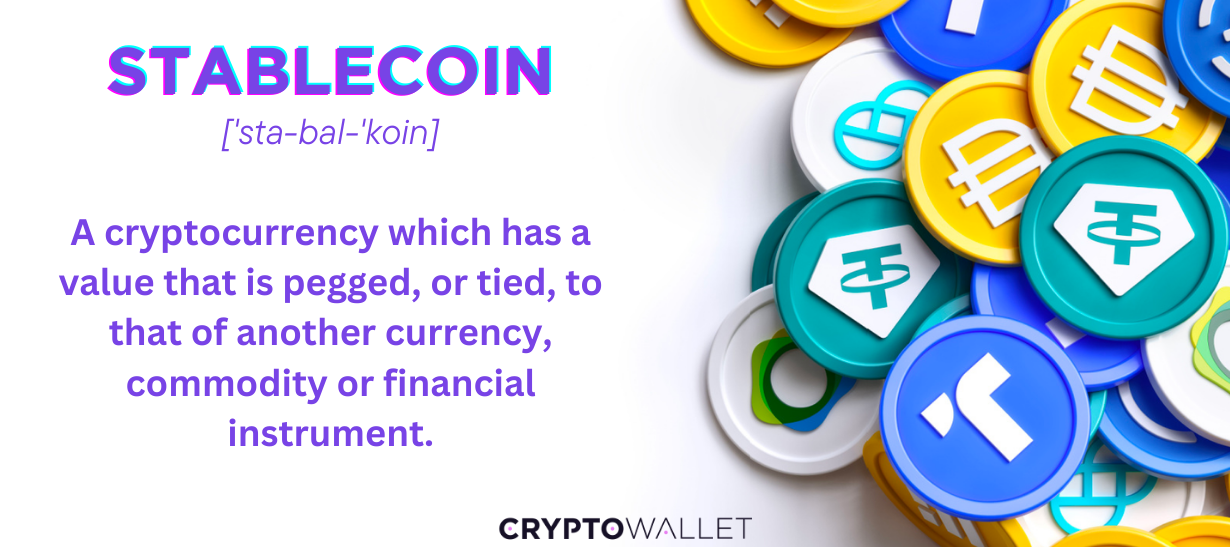
What are Stablecoins and How to Spend It?
Cryptocurrencies have taken the financial world by storm, with Bitcoin and other digital assets often making headlines for their volatility. However, within the world of cryptocurrency, there’s a subset of digital coins designed to offer stability and predictability. These are known as stablecoins, and they’re becoming increasingly popular due to their versatility and reliability.
In this blog, we’ll explore the concept of stablecoins, introduce you to some of the best stablecoins, and cover various ways to use stablecoins and spend them like traditional money.
SPEND STABLECOINS WITH THE BEST CRYPTO CARD
The CryptoWallet.com card offers you the flexibility to spend over 800 cryptocurrencies, including popular stablecoins like Tether (USDT), USD Coin (USDC), Binance USD (BUSD), Dai etc.
When you use the CryptoWallet.com card for payments, your crypto is directly converted into fiat at the current market rate, and there are no hidden fees to worry about. You also earn cashback rewards of up to 3% on your card purchases.
With our crypto card, you can harness the convenience of stablecoins just like traditional fiat currencies, making it easy to pay for your daily essentials, whether it’s your morning coffee, grocery shopping, or online purchases. Additionally, you can use the card at ATMs to instantly access cash using your stablecoins.

What Is a Stablecoin?
Stablecoin, as the name suggests, is a category of cryptocurrencies designed to maintain a stable value, often pegged to traditional assets like the U.S. dollar.
Unlike other cryptocurrencies, which can experience dramatic price fluctuations, stablecoins aim to provide a consistent value, typically adhering to a 1:1 exchange rate with their underlying reserve assets. This means that one unit of a stablecoin is always meant to be redeemable for one unit of the reserve asset, maintaining a steady value.

To ensure this stability, stablecoin issuers hold reserves of fiat currency or other assets equivalent to the amount of stablecoins in circulation. These reserves are regularly audited, providing transparency and trust for users.
Stablecoins serve as a bridge between traditional finance (TradFi) and digital assets, offering a reliable, blockchain-based alternative to conventional fiat money.
List of Popular Stablecoins
Several stablecoins have gained widespread recognition and adoption within the cryptocurrency community. Here are a few of the most notable ones:
Tether (USDT): Tether, often represented as USDT, is one of the earliest and most widely used stablecoins. It maintains a 1:1 peg to the U.S. dollar, providing stability in the world of cryptocurrencies.
USD Coin (USDC): USDC is another prominent stablecoin, jointly created by Coinbase and Circle Financial. Like USDT, it is pegged to the U.S. dollar, ensuring a consistent value.
Binance Dollar (BUSD): Issued by Paxos in collaboration with Binance, BUSD is an Ethereum-based stablecoin designed to offer users a reliable and easily tradable digital asset.
Dai (DAI): Unlike many other stablecoins, DAI operates within the decentralized finance (DeFi) ecosystem and is governed by the MakerDAO protocol. It is pegged to the U.S. dollar but offers a decentralized approach to stability.
Pax Dollar (USDP): Originally known as Paxos Standard (PAX), USDP is a regulated stablecoin provided by Paxos, a financial institution regulated by the New York State Department of Financial Services (NYDFS).
PayPal USD (PYUSD): PayPal USD is a US dollar–pegged stablecoin launched by the global payment services provider PayPal. PYUSD is an ERC-20 token, designed for digital payments and Web3 environments.
Euro Coin (EUROC): Similar to USDC but pegged to the euro, EUROC offers stability for users who prefer the European currency as their reference point.

Different Ways to Use Stablecoins
Stablecoins are incredibly versatile and offer a variety of use cases beyond just holding their value. Here are some common ways to utilize stablecoins:
Staking/DeFi/Web3
Stablecoins play a pivotal role in the world of decentralized finance (DeFi) by providing a stable asset that can be staked or used as collateral in various DeFi protocols. These activities often yield passive income in the form of interest.
Crypto Trading and Swapping
When trading cryptocurrencies, many users prefer using stablecoins as a safe haven during market volatility. Swapping a stablecoin for another digital asset can be a cost-effective way to acquire new crypto assets, reducing exchange fees.
Remittance and Payouts
Stablecoins are a practical choice for crypto payouts and remittances, especially for cross-border transactions. These transactions settle quickly and come with lower fees compared to traditional banking methods.
Spend with Merchants That Accept Crypto
A growing number of merchants and businesses now accept stablecoins as a payment method. This means you can use your digital assets for everyday expenses, whether it’s shopping for goods, services, or even entertainment.
Holding Stable Funds on Blockchain
During times of market turbulence, crypto traders often exchange more volatile coins for stablecoins to protect their holdings. This strategy also provides a haven during periods of high inflation when the value of fiat currency is steadily eroded.
Buy Gift Cards with Stablecoins
An easy way to spend your stablecoins is to purchase gift cards through platforms like the BitPay app or browser extension. This allows you to choose from a wide variety of brands and services and use your stablecoins to make purchases.
Why Get Paid in Stablecoins?
Receiving your income in stablecoins or holding stablecoin on the blockchain can offer several advantages, including:
Fast Payments: Stablecoins enable near-instantaneous transactions, making them ideal for quick and efficient payments. Whether you’re receiving a salary or payment for goods and services, stablecoins offer swift settlement.
Low Fees: Transaction fees associated with stablecoins are generally lower compared to traditional banking methods and even some other cryptocurrencies. This makes them a cost-effective option for payments, whether you’re paying or getting paid.
Stable Price: Unlike more volatile cryptocurrencies, stablecoins maintain a consistent value. This reduces the risk of price fluctuations between the time you receive payment and when you spend it. You can have confidence in the stability of your earnings.
Easy Integration: Stablecoins are widely supported by various wallets, exchanges, and payment platforms. This makes it easy to manage and use your funds for various purposes. Whether you’re looking to trade, invest, or spend, stablecoins offer a convenient option.
Crypto Card: Spend Stablecoins Like Fiat Money
If you’re looking for a seamless and convenient way to spend your stablecoins just like traditional fiat currency, crypto cards are your solution. A crypto card allows you to spend stablecoins directly from your crypto wallet. You can spend cryptos practically anywhere card payments are accepted.
Here’s how it works:
- Create a CryptoWallet.com account, complete the KYC process and order your Crypto Card.
- Buy stablecoins of your choice, such as Tether (USDT), USD Coin (USDC), Binance USD (BUSD), Pax Dollar (USDP), Gemini Dollar (GUSD), or Dai (DAI).
- You can either buy cryptos with a credit card or debit card or transfer cryptos to CryptoWallet.com account
- Once you have the cryptos on your CryptoWallet.com account, you can make purchases just like you would with traditional cash. Your cryptos are converted at the time of purchase.

In addition to simplifying your spending, the CryptoWallet.com card can come in handy when you receive your income in cryptocurrency and need a fast and cost-effective way to convert it for everyday use. Crypto cards offer you the flexibility of accessing your crypto funds without the hassle of constant conversion and withdrawal.
Stablecoins FAQs
What are Stablecoins?
Stablecoins are a type of cryptocurrency that is designed to have a stable value, often pegged to a reserve asset like a fiat currency (e.g., USD, EUR), a commodity (e.g., gold), or a basket of assets. They provide price stability and are commonly used for trading, remittances, and as a store of value in the volatile world of cryptocurrencies.
How do stablecoins work?
Stablecoins work by maintaining their value stability through different mechanisms, depending on their type:
Fiat-Collateralized Stablecoins: These are backed by an equivalent amount of fiat currency held in reserve. For example, for every USDT (Tether) issued, there is an equivalent amount of US dollars held in reserve.
Crypto-Collateralized Stablecoins: These use other cryptocurrencies as collateral to maintain their value. For example, DAI uses Ethereum as collateral.
Algorithmic Stablecoins: They use complex algorithms to control their supply and demand to maintain a stable price. The algorithm automatically adjusts the supply when the price deviates from the peg.
Hybrid Stablecoins: These combine elements of the above methods for better stability.
In all cases, the aim is to keep the stablecoin’s value as close to the peg as possible, even in the volatile crypto market.
Are stablecoins safe?
Stablecoins are considered safe in terms of maintaining a stable value because they are typically backed by reserves or collateral, undergo regular audits, and are subject to regulatory oversight.
However, like any financial asset, they may be exposed to risks such as regulatory changes or issues with the backing assets. It’s essential to choose reputable stablecoin providers and platforms to minimize these risks.
What was the first stablecoin?
The first stablecoin is often considered to be Tether (USDT), which was introduced in 2014. Tether is designed to maintain a stable value by pegging it to a reserve of traditional fiat currencies, such as the US dollar, in a 1:1 ratio. It played a significant role in the development of the stablecoin concept and has since been followed by many other stablecoins with various approaches to stability.
Are stablecoins really stable?
Stablecoins are designed to maintain a stable value, typically by pegging them to a reserve of traditional fiat currencies or other assets. While they aim for stability, they are not always perfectly stable. Several factors can influence their stability, including the management of the reserve, regulatory changes, and market demand.
Some stablecoins have experienced minor fluctuations in value, but they are generally more stable than most cryptocurrencies. It’s essential to choose reputable stablecoins with transparent reserve management to minimize stability risks.